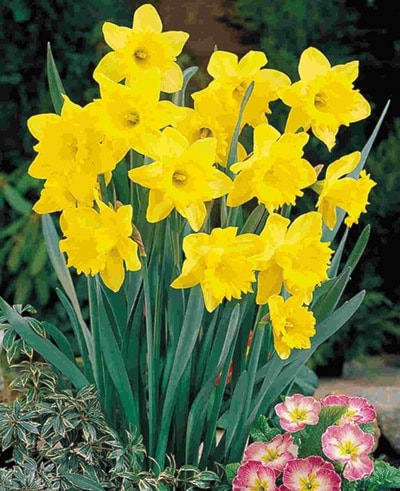Nothing in this world personifies spring like daffodils. Their vibrant yellows are the antidote to long wet winters. They just lift your spirits in so many ways. But … there’s no such thing as an ordinary yellow daffodil. Today, there are lots of choices.
‘Rijnveld’s Early Sensation’ blooms about 2-3 weeks earlier than any other varieties. Depending upon the weather in late winter, I’ve seen them bloom as early as late February and what a treat! When they bloom that early, snow and cold can happen at any time and I’ve seen them buried in snow and then pop back up and continue blooming. You’ll also find the earlier they bloom in cooler weather, the longer they bloom as well.
One of the complaints about daffodils and other spring bulbs is the relatively short time they perform in the garden. A really smart bulb distributor mixed early, mid and late-blooming daffodils together and branded them ‘Yellow Brick Road’. It’s amazing that these daffodils bloom and bloom while other displays simply end. Keeping that yellow colour going is a wonderful investment in early lasting colour. Don’t tell your neighbours why your daffodils out-bloom theirs – they make for nice bragging rights.
‘King Alfreds’ are perhaps the most well known old-fashioned daffodils, but honestly, they have been replaced by far better performing varieties. ‘Flower Carpet’ is one of the best for today’s West Coast gardens. It’s a stunning strong blooming yellow that is resistant to basil rot, which is a problem for many of the older varieties. It also stands up well in windy wet weather.
‘Carlton’ is a real stocky variety as well, and I love its sulphur yellow colour. It’s an oldie but goodie and a must for your garden.
Believe it or not, the very best selling daffodil today is the neatest, tidiest variety called ‘Teté-a-Teté’. It’s a superstar, growing about half the size of other daffodils. Each flower head has a cluster of tiny yellow blooms, creating a great show. Because of its smaller size, it out blooms and out performs almost any other variety. It is also one of the best naturalizers and repeat blooms year after year with an even better display. When the colour is gone, the biggest bonus is the smaller, neat and tidy foliage looks great in your garden.
Remember, if you’re planting now, all daffodils need well-drained sandy soil – no heavy clay. They will do equally well in full sun or partial shade. Plant them in a location where they can repeat bloom year after year, creating a long term display. We love them but the deer don’t, another added bonus.
